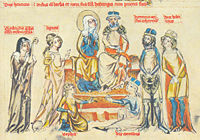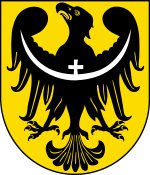Henry I the Bearded

Henry I the Bearded (Polish: Henryk I Brodaty; German: Heinrich I der Bärtige; 1163 – 19 March 1238), of the Silesian line of the Piast dynasty, was Duke of Lower Silesia from 1201. He was later also Duke of Lesser Poland and thus senior prince of all Poland from 1232 until his death.
Biography
Henry, son of a Silesian duke and German mother, was born in Głogów, Silesia.
In 1186, Henry and 12 year old Hedwig of Andechs (Polish: Jadwiga Śląska) were married at Burg Andechs. Hedwig was canonized in 1267. Their son and his successor, Duke Henry II the Pious, would be killed in 1241 battling the Mongols at Legnica (Liegnitz).
In 1201 Henry succeeded his father, Duke Bolesław I the Tall, who was subject of the Holy Roman Empire as he had received the Silesian ducal position following an 1163 intervention by Holy Roman Emperor Frederick I Barbarossa in a succession dispute. In 1205 he agreed to exchange the territories of Lubusz with Władysław III Spindleshanks of Greater Poland, receiving Kalisz. When in 1210 Conrad of Lusatia conquered Lubusz, Henry intervened and reconquered the region.

In 1217, through the mediation of the bishops of Poznań and Lubusz, he signed a treaty with Władysław Spindleshanks, which was approved by a Papal Bull on May 9 1218. By it, Henry gave back Lubusz and renounced any claim over Calisia Kalisz and other Ladislas Odonic's lands. In exchange, Henry was named heir to the childless Duke of Greater Poland.
In 1222-1223 he took part in the Crusades against the pagan Old Prussians. In 1225 he attempted to conquer Cracow, but had to raise the siege after a few days.
On November 23 1227, during an assembly of Piast dukes at Gąsawa, he was seriously wounded in an ambush by Ladislas Odonic and Świętopełk II of Pomerania, while Leszek I the White was killed in the same. This act started a feud for the conquest of the Polish throne, in which Henry supported Władysław III, who ultimately gained it. When in the summer 1228 Conrad I of Masovia attacked Lesser Poland, he was pushed back by Henry's son, Henry II the Pious; Conrad was however more successful the following year, being able also to take Henry I as prisoner. He was released under the promise to renounce Cracow. Later the Pope freed him of this promise obtained under constriction.
In 1230 he was to reunite the whole Silesia under his reign through the acquisition of the Duchy of Opole. Henry became Duke of Cracow in 1232, and assumed control over the Duchy of Sandomierz as the tutor of Bolesław V the Chaste.
In the Spring of 1231 Henry launched an offensive against Ladislas Odonic, who was claiming Greater Poland. The invasion was a failure. He was more successful three years later, when he managed to conquer Greater Poland up to the Warta River and even advanced into Pomeranian territory. In 1234 his son Henry II the Pious received the throne of Greater Poland.
During his reign, Henry improved the economy and infastructure of his lands by supporting the immigration of German settlers (Ostsiedlung), mainly from the home of his wife, Franconia and Bavaria.
Henry died at Krosno Odrzańskie in 1238 and was buried in the Cistercian church of Trzebnica (Trebnitz) which he had founded in 1202 on the request of his wife.
See also
- History of Poland (966-1385)
- Dukes of Silesia
| Preceded by Bolesław the Tall |
Duke of Wroclaw 1232-1238 |
Succeeded by Henry II the Pious |
|
||||||||||||||||||||||||||